Wroclaw, Poland's fourth largest city by population, has history spanning over a thousand years. It is considered as one of the most interesting and charming cities in Poland with grand monuments, picturesque old town and a UNESCO-listed hall.
|
 |
 |
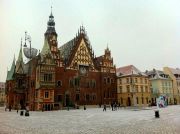 |
 |
 |
 |
 |
 |
The old Townhall in the middle of the main square
 |
 |
Wrocław is now Poland's fourth largest city. However, as many great cities in western Poland, it was not always Polish. Historical records indicate that it was established by the Bohemians and named Vratislavia before it fell into the hands of the Poles in 992. For about 250 years, only. In 1241, the inhabitants burnt it down as part of the defense mechanism again the Mongols. The remains of the settlement was repopulated by the Germans, and remained an independent city within the Hanseatic League of cities, despite the region being under the control of the Piasts, the Polish royal dynasty for further 100 years. Then, it was incorporated into the Holy Roman Empire - a curious name for the German country. And so for 600 years, between 1344 and 1945, the city was governed by the Germans and only a very small Polish population remained. Under the German rule, the city grew in importance and architectural significance.
For the most of the WWII, the city was largely left intact, and only the last few weeks of the war, brought large scale destruction and death of tens of thousands of inhabitants. The historical core of the city was rebuilt, and this part is in deed very interesting and attractive. One does not need more than a very full day to explore the old town on foot, rushing roughly through the interiors of churches, museums and galleries. Couple of days, or a weekend, should be sufficient to see everything at a good pace.
I went to Wroclaw on a number of occasions, but never visited it properly. When I was a kid, some quarter of a century ago, I saw more of the city than during all the years that followed, combined. And then, in October 2010 and then again in February 2011, I descended to Wroclaw suddenly. I made a few fresh photos and tried to see everything that I could not remember from my last visits some 25 years ago. The city has changed slightly. The old town is now vibrant and infrastructure is getting an upgrade in time for the UEFA's Euro 2012.
|
|
| Favourite spots: |
 |
 |
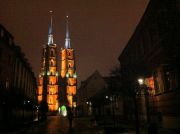 |
 |
 |
 |
 |
 |
The cathedral on the Ostrow Tumski island.
 |
 |
The picturesque Ostrow Tumski island (aka Dominsel, aka the Cathedral Island), the oldest part of the city was definitely my favourite spot. In my opinion, it looked best at night. The clever illumination of the churches, chapels, statues, monuments, brigdes, mansions and old houses made it look as if it was taken off the illustrations to a fairy-tale. Or a dark little story about somewhat creepy Medieval characters, who found this place to repent their sins. Or a dark tale about clergy plotting a string of events to identify and deal with witches, i.e. anyone who looked too pretty, too ugly, or happened to be slightly too clever. But seriously, the little island has its own ambiance and character. So different to the rest of the old town. The cobbled alleys there are narrower and the buildings are more tightly packed together. And the tall, two-tower cathedral dominates everything. It is like stepping a few centuries back in time.
|
|
| What's really great: |
 |
 |
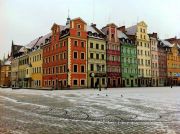 |
 |
 |
 |
 |
 |
Colourful tenement houses at the main square.
 |
 |
My second favourite spot in Wroclaw, is, of course, the Rynek, (aka Ring), the Old Square, complete with pictureque colourful facades of the narrow tenement houses and exceptionally photogenic Old Townhall built in the Gothic style. The Poles did a good job rebuilding this part of the city and preserving it after the war, even if it was not entirely politically correct, as according to the Socialist rule. The square is rather large and the structures in the middle of it, beside the Old Townhall, are furthermore intriguing with a few passages, alleys and squares almost in miniature.
And then there is the Solny Square, adjacent to the Rynek, as if it was an extension to the main piazza. It is flanked by even more tenement houses plus a massive palace. The square is occupied by an all year round flower market, which looks its best in the summer, obviously. In the winter, the flower sellers hide in pavillions and plastic covered booths.
|
|
| Sights: |
 |
 |
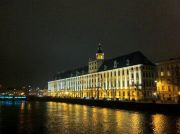 |
 |
 |
 |
 |
 |
The Wroclaw University's facade.
 |
 |
Amongst all of Wroclaw sights, the one most unlikely has been granted the accolade of the UNESCO World Heritage Site. It is the Hala Stulecia (aka Jahrhunderthalle, aka Centennial Hall), formerly known as Hala Ludowa, built by Max Berg between 1911 and 1913. It was a pioneering piece of architecture, which used reinforced concrete for the building material. It has a diameter of 69 meters and is 42 meters high. At the time of construction, it was the largest structure of its kind.
Apart from the aforementioned Cathedral Island, the Rynek and the 14th century Old Townhall, Wroclaw sights also include the main railway station (currently under renovation), the Water Tower, University of Wroclaw, University Library, St. Elisabeth's Church, the White Stork Synagogue (a truly rare sight in this former Nazi stronghold), Battle of Grunwald Square, the Grunwaldzki Bridge, aka Kaiserbruecke, (one of over a 100 bridges) and a certain large circular painting (see below).
|
|
| Accommodations: |
 |
 |
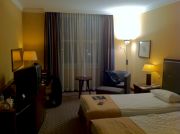 |
 |
 |
 |
 |
 |
Standard room in the Radisson Blue Hotel, across from the Raclawice Panorama
 |
 |
This time round, I was staying at the Radisson Blue Center Hotel between the Rynek and the Cathedral Island. It is a a modern four star establishment with all the predictable amenities. The personnel was professional and helpful, although not terribly knowledgeable about the city and its sights. The rooms are of a good size but the beds could have been more comfortable, considering the price. And I was not too hot about the bedlinen either. At the price of 400 zlotys (EUR100), one should expect more. The bathroom was spotless and all toiletries were available.
The lobby bar was nicely arranged, but it was not stocked terribly well with limited choice of beverages, be it alcoholic or non-alcoholic. However, the bartenders knew how to make an excellent cup of coffee (espresso, cappuccino, latte, machiato - take your pick!). And their orange juice was freshly squeezed in front of your eyes as you wait. Breakfast buffet was inlcuded. Free wifi internet available to all guests as standard.
|
|
| Nightlife: |
 |
 |
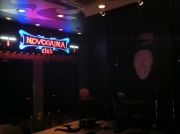 |
 |
 |
 |
 |
 |
The Novacaina Club - interior before party started
 |
 |
Wroclaw has Poland's third largest student population. This means that the city offers an excellent number of places to boogie and intoxicate oneself. As anywhere in Poland, certain clubbing venues go out of fashion from time to time, others become a trend, some last only a couple of semesters. So, it is always wise to ask around amongst the locals, which place is currently on the top of the partying map of the city.
I only had a peek at the Novacaina Club at the Rynek. It was a small place located in a cellar of the restuarant under the same name. It looked more like an upmarket spot. However, the Spiz Minibrewery always attracts a good mix of people, although there is no room to boogie there.
|
|
| Hangouts: |
 |
 |
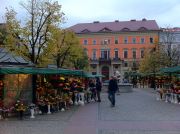 |
 |
 |
 |
 |
 |
The Solny Square, adjacent to the main Square (Rynek).
 |
 |
For those, who like to kill time with friends over coffee or a drink with a kick, Wroclaw offers countless cafes, cafeterias, pattiseries, bars and lounges. The most atmospheric ones are located in the old structures of the historical centre, particularly those in the narrow alleys and in the Gothic cellars. Some of those places have room only for a couple of tables. Some are a real labirynth of arched passage ways.
Those, who prefer outdoors, there are a number of parks and gardens, the Bothanic and Japanese gardens being especially popular amongst the locals.
And those, who like cities on the water, like Venice, Amsterdam or Sankt-Petersburg, Wroclaw has over a 100 bridges on offer and miles and miles of river (several rivers pass through the city) and canal banks to explore. The stretch between the Grunwaldzki Bridge and the University of Wroclaw has been recently revitilised and looks great. It offers also a fantastic view of the Cathedral Island.
|
|
| Restaurants: |
 |
 |
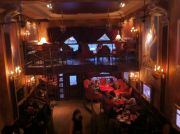 |
 |
 |
 |
 |
 |
The Novacaina Restaurant - seen from the balcony with three tables.
 |
 |
Wroclaw has a good number of good and excellent restaurants, many of which occupy old town houses at the Rynek.
Spiz, the Mini Brewery and Restaurant is one of the most popular, where customers can try their excellent and mega fresh golden beverages, the hefe-weizen ones going down particularly well. It is located at the cellar of the massive Cloth House, adjacent to the Old Townhall. The cellar of the Old Townhall, in turn, is occupied by the excellent Piwnica Swidnicka restaurant, which at the age of 738 years claims to be the oldest restaurant in Europe. The massive, recently renovated, 900 square meters cellar is divided in ten smaller rooms. It serves mainly traditional Polish dishes, but there is also room for some Italian and Bavarian dishes on the menu.
Almost opposite the Cloth Market, there is an excellent Italian eatery called Novacaina. Its decor is amazing, but the beef carpaccio and steaks might be the best in the city.
|
|
| Other recommendations: |
 |
 |
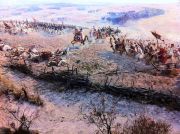 |
 |
 |
 |
 |
 |
The Raclawice Panorama painting with Kosciuszko in the centre.
 |
 |
Once in Wroclaw, one should not miss this special place - a small circular building housing a panoramic painting depicting the Battle of Raclawice, one of few of its kind in the world. The painting is 1.5 meters high and 11.4 meters long. The battle, which took place on 4 April 1794 and led by Tadeusz Kosciuszko (the multiple national hero of Poland, the United States, Lithuania and Belarus), was an important victory of the overall doomed uprising of the Poles against the Russian tsar. The painting is a rare example of the 19th century popular genre of naturalist painting. The viewer stands in the centre of the circular building and can observe the depicted event from a number of angles. Specially formed terrain, lighting and props create an additional illusion of reality. Clever narration explains the history of the painting and particular fragments of the battle. Horses are particularly well depicted on this piece and Tadeusz Kosciuszko is also given a great visual interpretation.
|
|
Published on Tuesday February 22th, 2011
|
|
 Publish on Facebook
Publish on Facebook
|
Sat, Mar 19 2011 - 10:33 AM
 by jorgesanchez
| You are a factory to produce good reports! |
Wed, Feb 23 2011 - 02:49 AM
 by pesu by pesu
| I'll take the Cappuccino! ;-) Good to see you back here, Krys! Thank you for this new report with its excellent mixture of historical, political, cultural facts, travel information and some magical dreaming. Great pictures as usual, too! :) |
| Information: |
| Login if you are a member, or sign up for a free membership to rate this report and to earn globo points! |
|
| Albania |
|
|
|
|
|
|
 |
| Antigua and Barbuda |
|
|
 |
| Argentina |
|
|
|
|
|
|
 |
| Armenia |
|
|
 |
| Aruba |
|
|
 |
| Australia |
|
|
 |
| Austria |
|
|
 |
| Azerbaijan |
|
|
 |
| Barbados |
|
|
 |
| Belgium |
|
|
|
|
|

|
